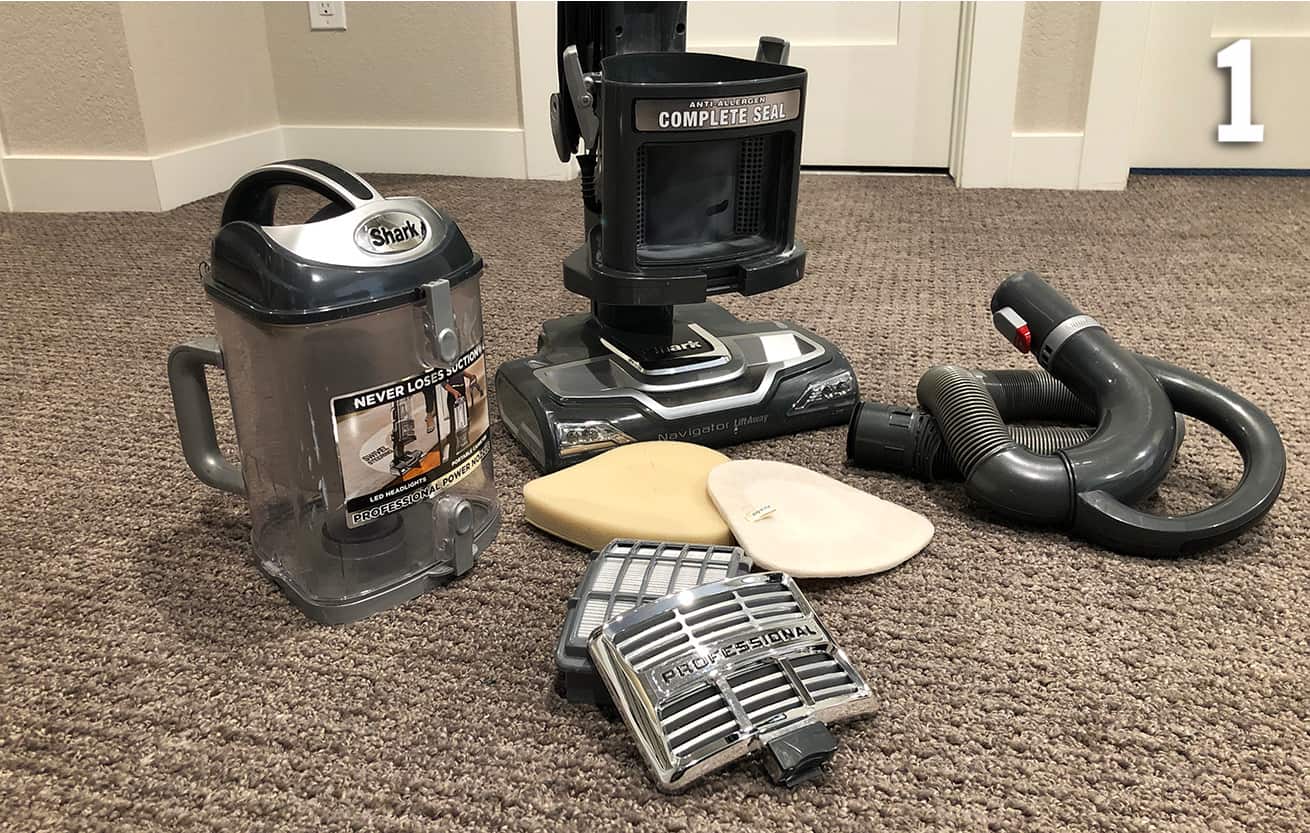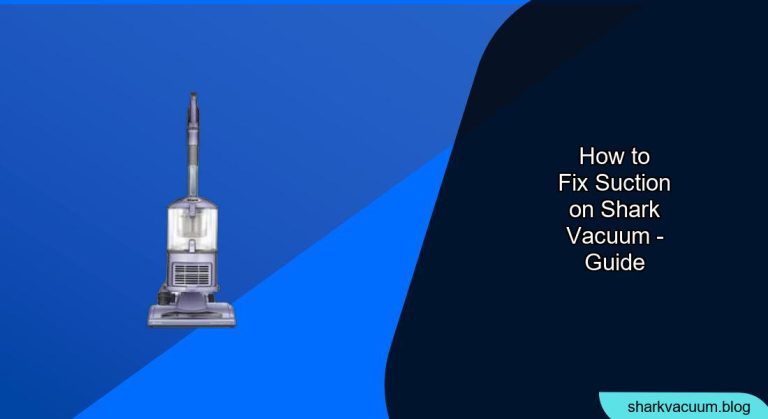Experiencing a loss of suction in your Shark vacuum can be incredibly frustrating. A vacuum cleaner without proper suction is essentially useless, leaving dirt and debris behind. Fortunately, many suction problems are easy to diagnose and fix yourself, saving you time and money on repairs or replacements.
This article will guide you through common causes of weak suction in Shark vacuums and provide step-by-step instructions to restore your vacuum’s cleaning power. By understanding the potential issues and following these troubleshooting tips, you’ll be back to efficiently cleaning your home in no time.
We’ll cover everything from checking for blockages and cleaning filters to inspecting hoses and brush rolls. Let’s dive in and get your Shark vacuum working like new again!
Table of Contents
Identifying the Cause of Suction Loss

Before you start taking your vacuum apart, it’s essential to identify the potential cause of the suction loss. Here are some common culprits:
- Clogged Filters: Dirty filters restrict airflow, which significantly reduces suction power.
- Blocked Hoses or Attachments: Obstructions in the hose or attachments prevent air from flowing freely.
- Full Dust Cup: An overfilled dust cup leaves no room for new debris, impacting suction.
- Tangled Brush Roll: Hair and string wrapped around the brush roll can hinder its rotation and reduce suction.
- Loose Connections: Gaps in the vacuum’s assembly can lead to air leaks and suction loss.
Step-by-Step Troubleshooting Guide
Once you’ve identified potential causes, follow these steps to troubleshoot and fix the suction on your Shark vacuum:
1. Empty the Dust Cup
The first and simplest step is to empty the dust cup.
- Detach the Dust Cup: Locate the release button or latch on your Shark vacuum and detach the dust cup.
- Empty the Contents: Hold the dust cup over a trash can and press the release button to empty the contents.
- Clean the Dust Cup: Rinse the dust cup with water and allow it to dry completely before reattaching. Ensure no debris is stuck in the cup.
2. Clean or Replace the Filters
Clogged filters are a primary cause of suction loss.
- Locate the Filters: Shark vacuums typically have one or more filters, usually located near the dust cup or motor. Consult your owner’s manual for the exact location.
- Remove the Filters: Carefully remove the filters from their housing.
- Clean the Filters: Tap the filters gently over a trash can to remove loose debris. Then, rinse them with lukewarm water. Avoid using soap or detergents.
- Dry the Filters: Allow the filters to air dry completely (at least 24 hours) before reassembling. Never put wet filters back into the vacuum.
- Replace if Necessary: If the filters are damaged or excessively dirty, consider replacing them. New filters can significantly improve your vacuum’s performance. Always check your owner’s manual to identify the correct filter type and the recommended replacement schedule for your specific model. You can often find replacement filters online . Regular filter changes help maintain strong suction and cleaner air.
3. Check for Blockages in the Hose and Attachments
Obstructions in the hose or attachments can severely restrict airflow.
- Detach the Hose: Disconnect the hose from the vacuum body and any attachments.
- Inspect the Hose: Look for any visible blockages in the hose.
- Remove Blockages: Use a broom handle or similar tool to gently dislodge any obstructions. Be careful not to puncture the hose.
- Check Attachments: Inspect all attachments, such as the crevice tool and dusting brush, for blockages.
- Reassemble: Once clear, reattach the hose and attachments securely.
4. Inspect and Clean the Brush Roll
A tangled brush roll can significantly impact suction and cleaning performance.
- Locate the Brush Roll: The brush roll is usually located on the bottom of the vacuum head.
- Remove the Brush Roll: Depending on your model, you may need to use a screwdriver or coin to unlock the brush roll cover.
- Remove Debris: Carefully remove any hair, string, or debris wrapped around the brush roll. Scissors or a seam ripper can be helpful.
- Clean the Brush Roll: Wipe the brush roll with a clean cloth to remove any remaining dirt.
- Reassemble: Reinstall the brush roll and secure the cover.
5. Check for Air Leaks and Loose Connections
Air leaks can reduce suction by diverting airflow away from the cleaning head.
- Inspect Connections: Check all connections between the hose, dust cup, and vacuum body to ensure they are secure.
- Check Seals: Examine the seals around the dust cup, filters, and motor for any damage or wear.
- Tighten Screws: Tighten any loose screws on the vacuum body.
- Test for Leaks: Turn on the vacuum and listen for unusual whistling sounds, which could indicate an air leak.
Troubleshooting Guide: Common Problems and Solutions
| Problem | Possible Cause | Solution |
|---|---|---|
| Vacuum has weak suction | Clogged filter | Clean or replace the filter. |
| Vacuum has no suction at all | Blocked hose | Detach the hose and remove any obstructions. |
| Brush roll not spinning | Tangled hair around the brush roll | Remove the brush roll and clean any hair or debris. |
| Vacuum overheating | Clogged filter or blocked hose | Check and clean both the filter and hose. |
| Unusual noise | Blocked hose or damaged brush roll | Check the hose for obstructions and inspect the brush roll for damage. |
Tips for Maintaining Optimal Suction

- Empty the dust cup after each use: Prevents overfilling and maintains consistent suction.
- Clean the filters regularly: At least once a month, or more often if you vacuum frequently.
- Inspect the brush roll regularly: Remove any tangled hair or debris to ensure smooth operation.
- Check for blockages frequently: Especially if you notice a sudden loss of suction.
- Replace filters as recommended: Refer to your owner’s manual for the recommended replacement schedule.
FAQ Section
How often should I clean my Shark vacuum filters?
You should clean your Shark vacuum filters at least once a month, or more often if you frequently use your vacuum. Regular cleaning helps maintain optimal suction and prolongs the life of your vacuum.
Can I wash my Shark vacuum filters with soap?
No, you should not use soap or detergents to clean your Shark vacuum filters. Soap can leave a residue that can damage the filters and reduce their effectiveness. Rinse the filters with lukewarm water only.
What happens if I put wet filters back into my Shark vacuum?
Putting wet filters back into your Shark vacuum can damage the motor and other components. Always allow the filters to air dry completely (at least 24 hours) before reassembling.
How do I know when to replace my Shark vacuum filters?
Check your owner’s manual for the recommended replacement schedule. Generally, you should replace your filters every 3-6 months, depending on usage. If your filters are damaged or excessively dirty, replace them sooner.
Why is my Shark vacuum losing suction after only a few minutes of use?
This could be due to a clogged filter, a full dust cup, or a blockage in the hose. Check these components and clean or empty them as needed.
Can a damaged hose cause suction loss?
Yes, a damaged hose with holes or cracks can cause air leaks and reduce suction. Inspect the hose for any damage and replace it if necessary.
Warnings and Best Practices
- Always unplug your Shark vacuum before performing any maintenance or repairs.
- Never operate the vacuum without the filters in place.
- Do not use the vacuum to pick up flammable or combustible materials.
- Avoid vacuuming liquids, as this can damage the motor and other components.
- Store the vacuum in a cool, dry place.
Conclusion
Maintaining the suction power of your Shark vacuum is essential for effective cleaning. By following this comprehensive guide, you can troubleshoot and fix most common suction issues yourself. Regular maintenance, such as emptying the dust cup, cleaning the filters, and checking for blockages, will help keep your Shark vacuum running smoothly for years to come.
If you’ve tried all the troubleshooting steps and your Shark vacuum still has weak suction, it may be time to consult a professional repair service or consider purchasing a new vacuum. However, with a little effort and attention to detail, you can often restore your Shark vacuum’s suction and keep your home clean and tidy.







